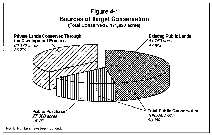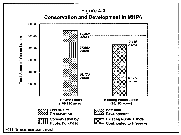Assembling the MSCP Preserve
The MSCP preserve will be assembled through a combination of the following methods:
- conservation of lands already in public ownership;
- public acquisition of private lands with regional habitat value from willing sellers; and
- private development contributions through development regulations and mitigation of impacts.
The relative contributions of these three methods and the equitable distribution of costs have been addressed in policies established by elected officials of several jurisdictions. These policies have served as the basis for plan proposals on assembling, implementing and financing the preserve.
Sources of Preserve Assembly
Of the total 171,920 acres targeted for preservation, public sources will contribute 81,750 acres of public lands and acquire approximately 27,000 acres of private lands. Approximately 63,170 acres of private lands will be conserved through the development process, including mitigation for impacts to biological resources outside the preserve. In total, the public sector will contribute 63.3% of the MSCP preserve, and private sector development will contribute 36.7%.
Table 4.1 Summary of Preserve Assembly (PDF)
Figure 4-1, Sources of Targeted Conservation.
View Larger Image (PDF)
The federal and state governments have acknowledged their role in habitat conservation and agreed to assist the local jurisdictions and property owners in creating a preserve that reduces or avoids the need to list additional species. The federal and state governments will contribute 36,510 acres of existing federal and state lands, excluding military lands, to permanent habitat conservation and management. This includes 24,510 acres managed by the Bureau of Land Management, three existing wildlife refuges that are part of the National Wildlife Refuge System and several state administered parks and reserves.
Local governments collectively own approximately 47,850 acres of habitat in the MHPA, of which 45,240 (94.5%) are targeted for permanent conservation and habitat management. Most of these lands are already protected in existing passive recreation parks and open space preserves. Approximately 10,400 acres, referred to as cornerstone lands, are owned by the City of San Diego Water Utilities Department and will be committed to habitat conservation through a conservation bank agreement with the wildlife agencies.
Over a period of 30 years, the federal and state governments, collectively, and the local jurisdictions in the MSCP study area, collectively, will each contribute half of the approximately 27,000 acres to be acquired by public means. Lands acquired as mitigation for public or private projects or through land use regulation will not be included as part of the acquisition obligation of the local jurisdictions. Funding of the local share of the preserve (acquisition, management, monitoring and administration) will be carried out on a regional basis.
In 1996, 43.8% (85,190 acres) of lands in the MHPA were owned by federal, state and local governments and 56.2% (109,130 acres) were privately owned. Of the MHPA lands in private ownership, 57.9% (63,170 acres) will be conserved in conjunction with private development, according to local land use regulations and through off-site mitigation; 24.7% (27,000 acres) will be publicly acquired; and 17.4% (18,900 acres) will potentially be developed (Figure 4-3).
Figure 4-3, Conservation and Development in MHPA.
View Larger Image (PDF)
Estimated Acquisition Need
The estimated need for acquisition of 27,000 acres was based on estimates provided by the five jurisdictions with most of the privately owned habitat lands within the MHPA: the cities of Chula Vista, Poway, San Diego and Santee and the County of San Diego. The estimates were based on detailed, site specific reviews of such factors as ownership patterns and parcel sizes, presence of biological resources, approved and negotiated projects, and the potential for future development given the application of land use regulations and environmental review.
More information about the MSCP Plan Summary:



